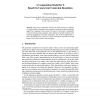Free Online Productivity Tools
i2Speak
i2Symbol
i2OCR
iTex2Img
iWeb2Print
iWeb2Shot
i2Type
iPdf2Split
iPdf2Merge
i2Bopomofo
i2Arabic
i2Style
i2Image
i2PDF
iLatex2Rtf
Sci2ools
109
Voted
ZUM
2000
Springer
2000
Springer
A Computation Model for Z Based on Concurrent Constraint Resolution
We present a computation model for Z, which is based on a reduction to a small calculus, called Z, and on concurrent constraint resolution techniques applied for computing in this calculus. The power of the model is comparable to that of functional logic languages, and combines the strength of higher-order functional computation with logic computation. The model is implemented as part of the ZETA system, where it is used for executing Z specifications for the purpose of test-data evaluation and prototyping.
Computation Model | Concurrent Constraint Resolution | Formal Methods | Functional Logic Languages | ZUM 2000 |
Related Content
| Added | 26 Aug 2010 |
| Updated | 26 Aug 2010 |
| Type | Conference |
| Year | 2000 |
| Where | ZUM |
| Authors | Wolfgang Grieskamp |
Comments (0)

